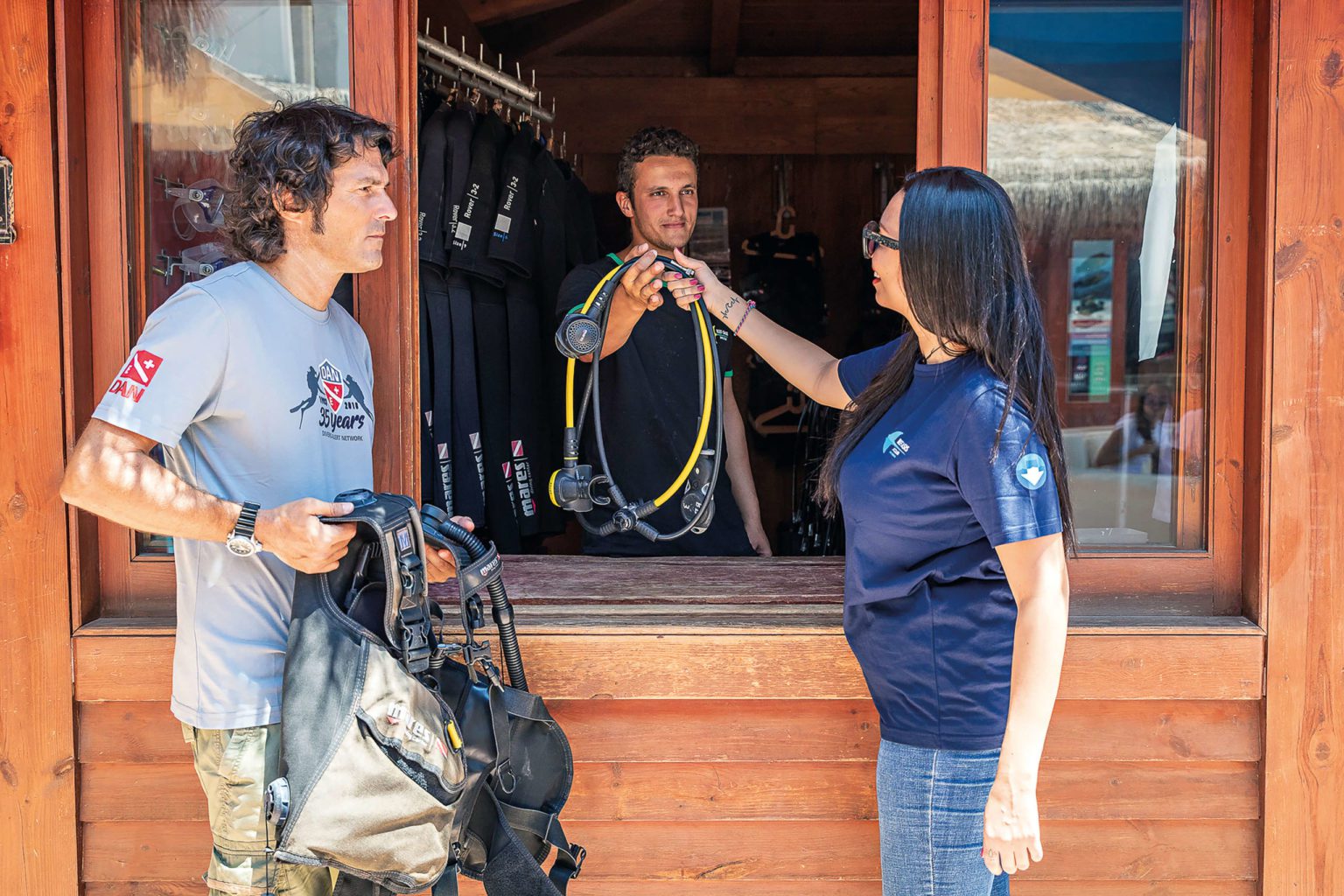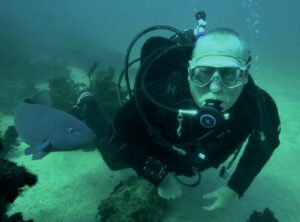Michael Menduno offers up some sage advice on methods of cleaning and disinfecting your dive gear
With the COVID-19 pandemic easing and people slowly returning to diving, it seemed appropriate to revisit our recommendations regarding disinfecting scuba equipment. Accordingly, we reached out to nearly a dozen manufacturers for their input and latest recommendations. Note that DAN US published a quick guide to disinfecting scuba equipment in March 2020, which was later updated in June 2020 and titled Disinfection of Scuba Equipment and COVID-19.
Of course, it continues to be important to rinse and clean your scuba equipment to prevent wear and premature ageing, as has been discussed in prior articles. However, as everyone is aware, the pandemic has introduced additional requirements.
How To Disinfect Your Dive Gear
Though it might not be necessary to disinfect your own gear after diving, all of the vendors we spoke to agreed that it is essential to disinfect scuba equipment that comes into contact with a diver’s face, eyes and mouth before sharing the equipment with other divers. This includes but is not limited to the second stage regulator mouthpiece and internal surfaces, snorkel, BCD oral inflator and mask. Rebreather manufacturers also pointed out that it is essential to regularly disinfect the breathing loop to prevent the growth of harmful bacteria even if it is only used by one diver.
It is also to keep in place protocols that minimize the possibilities of transmission. This includes social distancing, washing/sanitizing hands before and after touching their own and someone else's gear – that is before and after the dive in most instances. Note that being in water may reduce contact transmission risks, but experts remain divided on the degree or duration required to inactivate COVID-19 in particular, so a conservative approach is recommended. So for example, it is best to modify gas sharing drills, so that divers do not breathe off another’s regulator.
Disinfectant Products
Vendors recommended some commonly used disinfectants including Virkon products including Rely+On Virkon, Virkon S, and Chemgene, that have shown to be effective against the virus. Other products such as sodium hypochlorite, the active ingredient in bleach, which is inexpensive and readily available, have been studied in many different concentrations, and its effectiveness against viruses has been proven.
In a study that examined COVID-19 specifically, it was found that a sodium hypochlorite concentration of 0.1% or 1,000 ppm in water was needed to reduce infectivity when sprayed onto a hard-non-porous surface. A second study on the same virus found that 0.1% sodium hypochlorite would inactivate the virus within one minute. CDC recommends a solution of 1/3 cup bleach per gallon of water (22 ml bleach per litre of water) with a soaking time of 1-2 minutes for hard, nonporous surfaces. This relatively weak 2% bleach solution and short contact time should not cause damage to scuba regulators.
When using bleach, the use of gloves, a mask, and eye protection are encouraged. It is important to read the product label carefully, check the percentage of the active ingredients, and dilute it in water in the right ratio. Mix the water and bleach solution in well-ventilated areas, and use cold water, as hot water will decompose the active ingredient.
Items disinfected with bleach must be thoroughly rinsed with fresh water and allowed to dry before use, as it is corrosive to stainless steel (in higher concentrations) and irritating to mucous membranes, skin and eyes. Highly concentrated bleach solutions have also been found to be harmful to life-support equipment. Do not use bleach in rebreather counterlungs and other breathing loop components unless advised otherwise by the manufacturer. Disinfect counterlungs as directed by the manufacturer.
Vendors also mentioned quaternary ammonium compounds, or quats, such as Steramine and Barbicide, which are commonly used to disinfect rebreathers and are frequently active ingredients in cleaning solutions. These agents are hydrophobic and as such are effective against enveloped viruses; quats are thought to react with the viral envelope and ‘disorganize’ it, leading to the contents of the virus leaking out and degrading. The World Health Organization (WHO) recommends the use of products containing these compounds to fight the coronavirus disease. However, quats are also harmful to the environment, so care must be taken in their use and disposal. Please responsibly dispose of these chemicals (for example, down a drain leading to a wastewater treatment plant), as they can negatively affect marine life, especially algae and micro-organisms.
Alcohol can also be used to combat COVID-19. According to the Centre for Disease Control (CDC), an alcohol solution of at least 70% isopropanol or ethanol can be used to disinfect surfaces. However, repeated use of alcohol can harm certain types of plastic and rubber by causing swelling, hardening and cracking of these materials, so it is most likely not the best disinfectant to use on scuba equipment.
In Europe, the European Centre for Disease Prevention and Control (ECDC) has published guidelines about disinfecting for COVID-19. In the US, the Environmental Protection Agency (EPA) has also published a list of disinfectants that are effective against COVID-19.
Environmental Considerations
Given the increase in equipment disinfection and attention to effective disinfectants, it’s important to consider the environmental aspects. Disinfectant products kill micro-organisms and continue to kill or cause harm, even in diluted form, when discharged into the environment until they break down. Accordingly, we recommend that you consider the following to make sure that you disinfect your equipment in an environmentally-friendly manner.
Check the safety data sheet (SDS) for the product you’re using, and never discharge a disinfectant solution into the environment. The SDS includes information such as environmental and human toxicity, proper disposal and other important information.
Thoroughly rinse disinfected scuba equipment with fresh water, and allow it to dry. Small amounts of disinfectant will be in your rinse water, so that also requires responsible disposal. Follow manufacturer guidance for waste disposal.
You are safe using disinfectants registered with the U.S. Environmental Protection Agency (EPA) that are effective against any specific or local microorganisms of concern. Unfortunately, there isn't a European equivalent. You can look up the EPA registration for a specific disinfectant in the Pesticide Product and Label System to determine if you can use the product on scuba equipment, respirators or other breathing equipment.
Even if cleaning products are labelled as environmentally friendly, never dump them overboard or pour them onto the ground. Dispose of them as specified on the product’s SDS.
In conclusion, as long as the pandemic persists, it’s important to properly disinfect your scuba equipment if it is to be used by others, and in a way that does not harm the environment. Know the composition of the products you use, and be aware of the potential impacts of disposal. It is our responsibility as divers and dive operators to care for and preserve the aquatic environment that we love. Thank you!
Additional Resources:
Environmental Considerations for Disinfection (February 2021) By Francois Burman, Pr.Eng., M.Sc., and Chloe Strauss.
You can see more content from Dan Europe from their regular column, or check out the DAN website for more information about medical advice and diver insurance.









It is also worth considering anti fungal treatments for rebreather counter lungs and BCD bladders. Then ensuring the counter lung or bladder are fully dry otherwise fungal material can continue to be present. As has been seen in the past with fatal consequences.